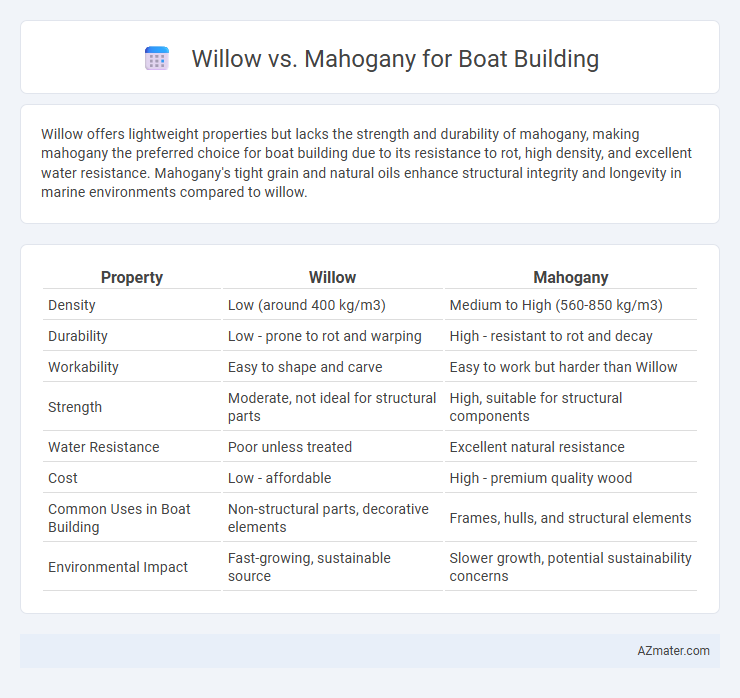Willow offers lightweight properties but lacks the strength and durability of mahogany, making mahogany the preferred choice for boat building due to its resistance to rot, high density, and excellent water resistance. Mahogany's tight grain and natural oils enhance structural integrity and longevity in marine environments compared to willow.
Table of Comparison
| Property | Willow | Mahogany |
|---|---|---|
| Density | Low (around 400 kg/m3) | Medium to High (560-850 kg/m3) |
| Durability | Low - prone to rot and warping | High - resistant to rot and decay |
| Workability | Easy to shape and carve | Easy to work but harder than Willow |
| Strength | Moderate, not ideal for structural parts | High, suitable for structural components |
| Water Resistance | Poor unless treated | Excellent natural resistance |
| Cost | Low - affordable | High - premium quality wood |
| Common Uses in Boat Building | Non-structural parts, decorative elements | Frames, hulls, and structural elements |
| Environmental Impact | Fast-growing, sustainable source | Slower growth, potential sustainability concerns |
Introduction to Boat Building Woods
Willow and mahogany serve distinctly different purposes in boat building due to their material properties. Willow is lightweight and flexible but lacks the durability and water resistance essential for structural boat components. Mahogany's dense grain and natural resistance to rot make it a preferred choice for constructing hulls and decks, ensuring longevity and performance in marine environments.
Overview of Willow and Mahogany
Willow is a lightweight, flexible wood known for its shock resistance and ease of shaping, making it suitable for small boat frames and paddles. Mahogany is a dense, durable hardwood prized for its natural rot resistance, rich reddish-brown color, and excellent workability in marine environments. Builders often choose mahogany for hulls and exterior components due to its strength and longevity compared to willow.
Wood Density and Weight Comparison
Willow wood has a density of approximately 400 kg/m3, making it significantly lighter than mahogany, which has a density ranging from 550 to 850 kg/m3 depending on the species. This lower density gives willow an advantage in applications where weight reduction is critical, such as in small or lightweight boats. Mahogany's higher density contributes to greater strength and durability, making it suitable for larger, heavier boats that require robust structural integrity.
Durability and Rot Resistance
Mahogany is renowned in boat building for its exceptional durability and superior rot resistance, making it a preferred choice for both structural and aesthetic components. In contrast, willow lacks the natural oils and density that contribute to wood longevity, rendering it less suitable for marine environments prone to moisture and decay. Choosing mahogany ensures enhanced lifespan and minimal maintenance against fungal attacks in wet conditions.
Workability and Ease of Shaping
Willow offers excellent workability due to its light weight and softness, making it easy to cut, shape, and carve for intricate boat components. Mahogany provides superior ease of shaping with its fine, even grain, allowing for smooth finishes and precise joins, essential for high-quality boat construction. Both woods perform well, but willow is preferred for rapid prototyping and detail work, while mahogany excels in durability and aesthetic appeal during shaping.
Water Absorption and Stability
Willow has a lower water absorption rate compared to mahogany, making it less prone to swelling and warping in marine environments. Mahogany offers superior dimensional stability due to its dense grain structure, which helps maintain the boat's shape over time. Both woods perform well in boat building, but mahogany's combination of strength and stability often makes it the preferred choice for durability in water exposure.
Strength and Structural Integrity
Mahogany offers exceptional strength and structural integrity in boat building due to its dense, tight grain and natural resistance to rot and pests, making it highly durable in marine environments. Willow, while lightweight and flexible, lacks the hardness and long-term resilience of mahogany, often leading to reduced structural strength under heavy stress or constant water exposure. For applications requiring maximum load-bearing capacity and longevity, mahogany is the preferred choice over willow in vessel construction.
Cost and Availability
Willow is significantly more affordable and widely available compared to mahogany, making it a cost-effective choice for budget-conscious boat builders. Mahogany, prized for its durability and aesthetic appeal, tends to be more expensive and less readily accessible due to limited supply and sustainable harvesting regulations. The difference in price and availability often influences the decision between using willow or mahogany in boat construction projects.
Environmental Impact and Sustainability
Willow and mahogany differ significantly in environmental impact and sustainability for boat building. Willow is a fast-growing, renewable resource with a lower carbon footprint and minimal ecological disturbance, making it a more sustainable choice. Mahogany, often sourced from slow-growing tropical hardwood forests, faces sustainability challenges due to deforestation and habitat loss, raising concerns about its long-term environmental impact.
Best Applications: Willow vs Mahogany
Willow's lightweight and flexibility make it ideal for small, non-structural boat parts like paddles and lightweight hulls, where ease of shaping and shock absorption are crucial. Mahogany excels in structural applications due to its superior durability, water resistance, and rot resistance, making it perfect for hulls, decking, and frames of traditional and classic wooden boats. Choosing mahogany ensures long-lasting strength and aesthetic appeal in marine environments, whereas willow suits lightweight, less load-bearing components.

Infographic: Willow vs Mahogany for Boat Building
 azmater.com
azmater.com